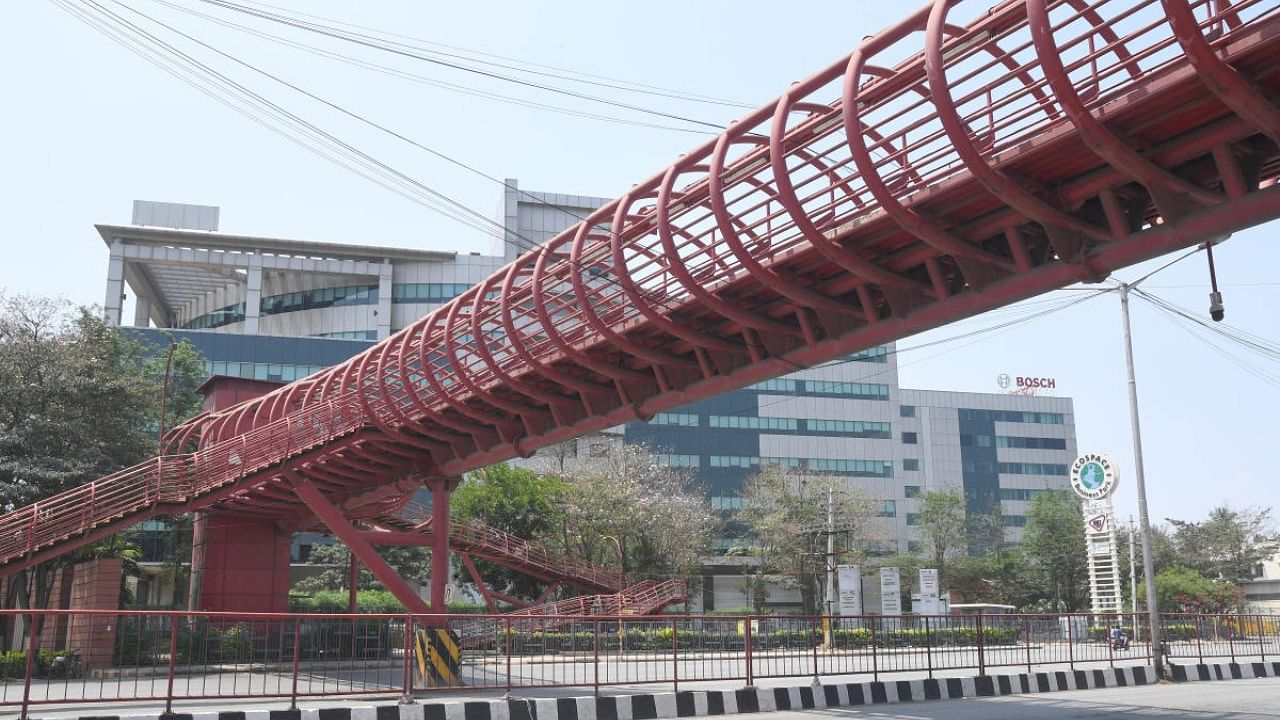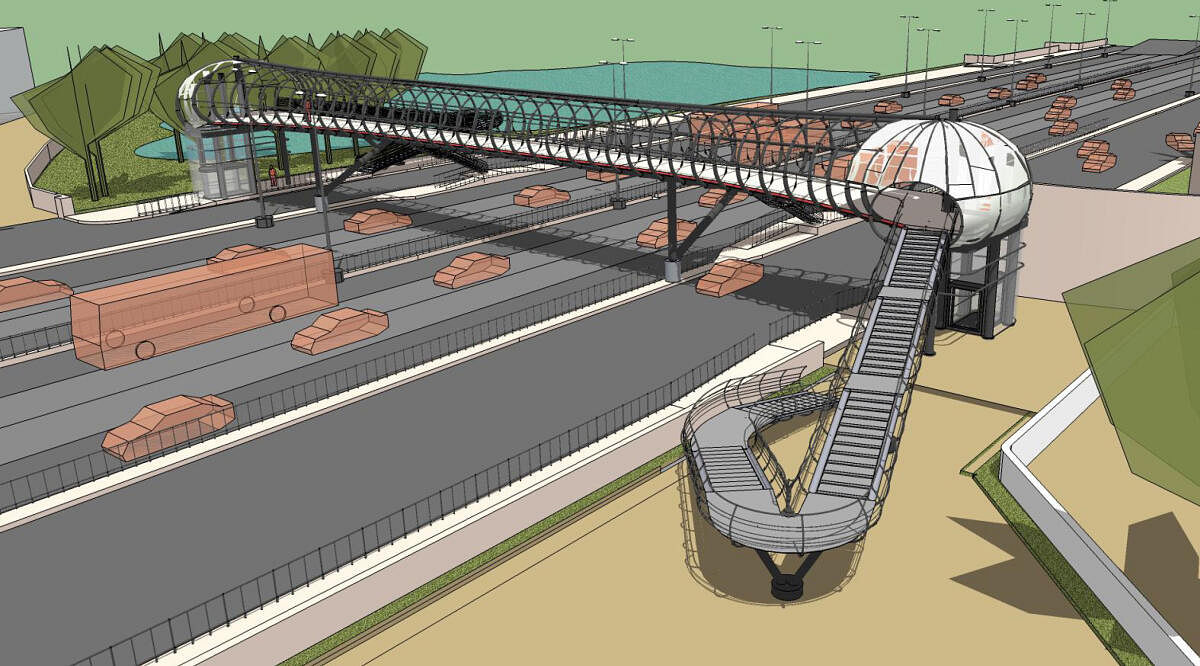

Imagine skywalks at signalled intersections? Traffic and mobility experts will say that it goes against common sense. Why force pedestrians to take an elevated route, when they can simply walk across? But what if a road is arterial with vehicles zipping past at high speeds and a signal a kilometre away? This sounds like a design problem in search of a compelling solution.
Springing up at myriad traffic junctions, skywalk sounds like a fancy term for foot over bridge (FOB). It seems by design to suit advertisers — waiting motorists at these intersections get a fancy view of billboards. Pedestrians get the last priority in this design.
Also Read | Few takers for skywalks but BBMP plans 40 more
Does this become only a location problem? At first sight it would seem so, because skywalks are rarely used by walkers across Bengaluru. The elderly, children, disabled, and those carrying heavy loads would rather risk crossing a road at ground level, even if the signal-crossing time has taken a nosedive.
Accessibility issue
However, there is a clear design flaw, as mobility experts point out. “Pedestrian bridges, although initially appealing, often face problems with practicality and accessibility. Their design, which includes steep stairs or ramps, leads to longer crossing distances compared to street crossings at ground level,” notes Nikita Luke, senior project associate (health and road safety) at the World Resources Institute.
Besides, she says, inadequate maintenance and poor lighting conditions on many such bridges can contribute to an unwelcoming atmosphere, often causing unease and apprehension, particularly among women. Dysfunctional elevator lifts at most skywalks are part of this vexing maintenance issue.
Mobility analysts are convinced that skywalks are best kept away from local roads. Some architects see these bridges as the option only where signalled junctions are too far. This implies installing them in the middle of an extended stretch. If the footpaths are wide enough, they recommend bridges with ramps to gain the height.
Former special commissioner (Traffic), Bengaluru City, M A Saleem agrees that skywalks make no sense at signalled junctions. “At these intersections, time is anyway given for pedestrian crossing. A skywalk may even become an impediment there,” he adds.
Skywalks are ideal on busy, one-way roads. “It is important that they are integrated with working elevators and have sufficient height to let cargo-laden vehicles pass under. A vertical margin of at least 20 ft is essential, which would mean climbing 40 steps. Senior citizens would find this tough — elevators are a must,” says Saleem.
Strict specifications
Nikita stresses that FOBs have to adhere to strict design specifications. Along Tumakuru Road, such well-designed FOBs could help pedestrians bypass the heavy traffic to access Peenya, Peenya Industry, Jalahalli and T Dasarahalli Metro Stations from the opposite side.
Inclusivity and accessibility for all are key for effective design. Nikita explains, “Pedestrian bridges must cater to all, including children, women, the elderly, and individuals with disabilities. This necessitates the integration of elevators, escalators, well designed ramps, and other features to improve accessibility.”
Aesthetics
Design aesthetics is also critical to ensure that they blend seamlessly with the urban landscape. The chosen material should offer durability and ease of maintenance. Enhancing the pedestrian experience could mean transforming these bridges into vibrant spaces featuring seating areas, landscaping, or even art installations.
Structural design standards mandate a width of 1.8 to 2.5 metres to accommodate the projected pedestrian traffic. This width could, however, be adjusted to match higher footfalls. If the bridge is covered and has structural elements above the walkway, a minimum clear headroom of 2.5 metres is recommended. This headroom is measured from the finished level of the bridge floor to the underside of the upper cover, ensuring adequate vertical space.
Ramps and railings
Ramps and railings are often the best alternative to stairs, a key feature of all skywalks in the city. But, as Nikita points out, the gradient of ramps should not exceed 1 in 20, and only in exceptional circumstances should they exceed a gradient of 1 in 15. “Steeper gradients than 1 in 12 should be avoided altogether.”
Unlike stairs, ramps might be easy to navigate for people. However, Saleem flags a concern: “Ramps need a lot of surface, the area requirement is very huge. To gain a height of 20 ft, you need almost 70-80 ft of ramp length, which will eat into the footpath space.” The message is clear: Ramps can be installed only on roads with wide walkways.
Beyond stairs and ramps, railings, with a minimum height of 1.1 meters, are mandated on both sides of the skywalk. If its width exceeds 3 meters, additional central railings are to be installed.
Safety measures
These safety measures should be supplemented with adequate lighting, surveillance systems, protective handrails, and anti-slip surfaces. Security cameras, emergency call boxes, and evening patrols are recommended for women’s safety. FOBs are required to be well-lit to enhance night-time visibility, promoting safer and more efficient use of walkways, ramps, and stairs.
Signage complements good design. Clear and visible signs are to be installed to facilitate easy navigation and use of accessibility features.
Underpasses are susceptible to flooding. Any serious drainage flaws can aggravate the problem. But if poorly designed, water can accumulate on FOBs too. It is crucial not only to divert water away from the bridge but also ensure that it is not discharged onto the carriageway or footpath below.
For urbanist Ashwin Mahesh, skywalks work well only when they are designed as short connecting bridges between say, a Metro station or a bus station and a mall.
“They should be seen as integration facilities, linking transit points. But a skywalk as a substitute for crossing the road at grade is an admission of failure, and shows a lack of imagination,” he contends, instead pitching for wide underpasses to cross busy roads.